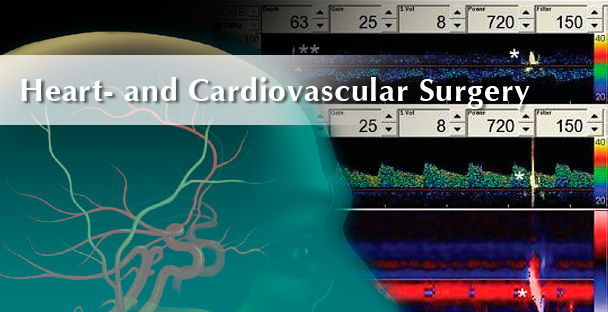
01 März 2022 Reducing the risk of stroke in Cardiovascular Surgery with Emboli Detection
TCD for Monitoring and Emboli Detection in Carotid Cardiovascular Surgery
Since intraoperative strokes are predominantly caused by embolism instead of inefficient hemodynamic circulation (Spencer et al., 1997), the occurrence of embolic signals may lead to a change of surgical treatment and thereby help to reduce the risk of intraoperative stroke. Emboli detection becomes particularly relevant in cardiovascular surgery, when the arterial system needs to be opened (e.g. carotid surgery). Among emboli detection, TCD even allows a continuous monitoring of cerebral hemodynamics.
A major advantage of transcranial ultrasound is its suitability for continuous monitoring. Microembolic signals (MES) are brief, high-intensity transients that occur when particulate microemboli or gaseous microbubbles pass through the ultrasound beam.
Cerebral embolism is a major reason of ischemic strokes and account for about 20-30% of strokes.
Cardiovascular surgery
Embolic signals during carotid surgery should be classified into three categories, which occur at different stages and do have different clinical relevance.
- Preparation of the vascular segment
- a. Normally: fragile plaques: high risk of neurological symptoms.
- Re-opening of vascular flow
- a. Normally: gasous emboli, which are rather non-hazardous.
- Postoperatively (within 1-2 hours)
- a. Postoperatively, in about 20% of patients microembolic signals are detectable, which correlates with an increased risk for new strokes. Regarding this purpose, scientific Literature outlines a threshold of about 50 counts per minute.
Carotid endarterectomy (CEA)
The benefit of carotid endarterectomy (CEA) in patients with symptomatic severe carotid stenosis is highly dependent on the perioperative stroke rate. Cerebral monitoring plays an important role in reducing the perioperative stroke rate as it allows detection of the main causes of perioperative stroke, being embolism, intraoperative hypoperfusion and postoperative hyperperfusion syndrome. However, some physicians doubt about the benefit of cerebral monitoring and consider it costly and time consuming.
Carotid angioplasty
Up to now, referring to carotid angioplasty (e.g. stenting), there was no significant correlation between count of MES and postoperative ischemic events.
Carotid stenosis (q.v. seperate chapter)
Surgery on cardiopulmonary bypass circulation
- Gasous MES, which are generated due to oxygenation with the extracorporal circulation. These emboli may be reduced by particular filters.
- Inadequate air elimination of the cardiac cavern following cardiac surgery. Clinical relevance is depending on the amount of air.
- MES during clamping and re-opening of the aortic arch (plaque material) – often mixed with gasous signals. Clinical relevance of these signals would only be significantly assessable by emboli differentiation (e.g. EmboDop©)
Heart valve implants
Regarding symptomatic patients with heart valve implants, particularly mechanical valves, differentiation between gasous and solid emboli becomes clinically relevant. Microembolic signals ware supposed to be a marker for efficiency of anticoagulant drugs. A long time, the exact benefit was unclear.
Since a couple of years it is well known that mechanical heart valves generate gasous bubbles, which are caused by cavitation (differences in pressure release/dissolve nitrogen bubbles) and are considered as relatively harmless. However, in case of neurological symptomatic patients, the heart valve should otherwise be considered as a source of thrombotic material.
Differentiation between “harmless” gaseous and “dangerous” solid emboli could be importantly helpful in administration of anticoagulant drugs.
